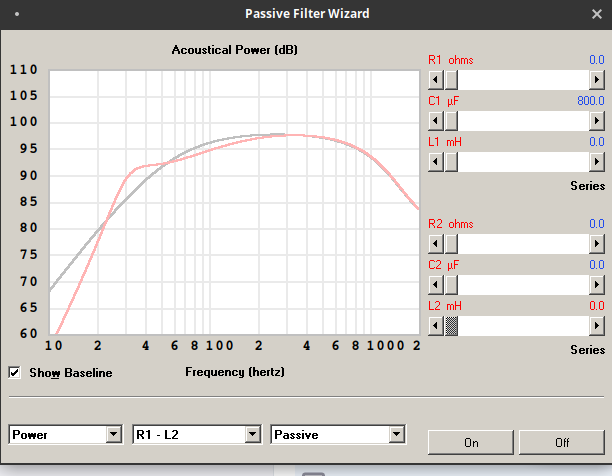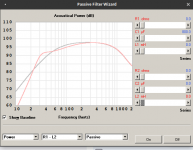I was thinking about using a large blocking cap on OB woofers to provide some protection from excursion damage if connected to a full range amplifier (no active high pass). Hornresp shown an interesting interaction in that the response really resembles an Extended Bass Shelf ported alignment. Is this real? If so it could be useful in a normal sealed enclosure to extend the usable bass response without the driver unloading problem of a ported enclosure. Of course it is entirely possible that the resonances might lead to a bit of flabby bass.
Has anyone messed with this before?

Has anyone messed with this before?
Attachments
That`s a 3rd-order assisted alignment when used in a sealed enclosure, unless I'm mistaken. The large capacitor resonates with the inductive reactance of the driver/box impedance peak. It will increase excursion over the range where there is some LF gain, but provide some protection at VLF.
interesting example of deep-bass-small-cabinet by using capacitor in series with the woofer is 'black box' design
https://www.humblehomemadehifi.com/download/Humble Homemade Hifi_Black Box.pdf
https://www.humblehomemadehifi.com/download/Humble Homemade Hifi_Black Box.pdf
Very interesting articles, thanks.interesting example of deep-bass-small-cabinet by using capacitor in series with the woofer is 'black box' design
https://www.humblehomemadehifi.com/download/Humble Homemade Hifi_Black Box.pdf
Hmm... makes me wonder if it could be used to improve on the Realistic Mach 1 without increasing box size.
BTW, any thoughts on whether each woofer in a multi woofer design should have its own cap or not?
KEF and Infiniti both produced several loudspeakers using this method back in the 80s - 90s.
Another thread on the topic here:
https://www.diyaudio.com/community/threads/passively-assisted-sealed-alignments.360786/post-6356151
Here are 2 AES papers and a patent on the technique you may find of interest.
Low-Frequency Range Extension of Loudspeakers
Author: von Recklinghausen, Daniel R.
JAES Volume 33 Issue 6 pp. 440-446; June 1985
“A passive electric network connected between the driving amplifier and a closed-box direct-radiator loudspeaker can extend the low-frequency response of the loudspeaker system to frequencies below the diaphragm mass-enclosure compliance resonance without requiring additional voltage output capability of the amplifier. Design details for such a closed-box system are shown”
AES E-Library >> Low-Frequency Range Extension of Loudspeakers
Closed-Box Loudspeaker with a Series Capacitor
Author: Thiele, Neville
JAES Volume 58 Issue 7/8 pp. 577-582; July 2010
“Adding a series capacitor to a closed-box loudspeaker modestly extends the low-frequency response, enabling the use of a smaller enclosure. In addition, the capacitor offers substantial protection against excessive voice-coil excursions from subsonic input signals. The capacitor converts a second-order system to third order. A design procedure for the composite system in closed form is provided, allowing the resulting transfer function to be optimized for group delay, frequency response, and cone excursion.”
AES E-Library >> Closed-Box Loudspeaker with a Series Capacitor
US Patent US4383134A:
US4383134A - Loudspeaker systems
- Google Patents
Another thread on the topic here:
https://www.diyaudio.com/community/threads/passively-assisted-sealed-alignments.360786/post-6356151
Here are 2 AES papers and a patent on the technique you may find of interest.
Low-Frequency Range Extension of Loudspeakers
Author: von Recklinghausen, Daniel R.
JAES Volume 33 Issue 6 pp. 440-446; June 1985
“A passive electric network connected between the driving amplifier and a closed-box direct-radiator loudspeaker can extend the low-frequency response of the loudspeaker system to frequencies below the diaphragm mass-enclosure compliance resonance without requiring additional voltage output capability of the amplifier. Design details for such a closed-box system are shown”
AES E-Library >> Low-Frequency Range Extension of Loudspeakers
Closed-Box Loudspeaker with a Series Capacitor
Author: Thiele, Neville
JAES Volume 58 Issue 7/8 pp. 577-582; July 2010
“Adding a series capacitor to a closed-box loudspeaker modestly extends the low-frequency response, enabling the use of a smaller enclosure. In addition, the capacitor offers substantial protection against excessive voice-coil excursions from subsonic input signals. The capacitor converts a second-order system to third order. A design procedure for the composite system in closed form is provided, allowing the resulting transfer function to be optimized for group delay, frequency response, and cone excursion.”
AES E-Library >> Closed-Box Loudspeaker with a Series Capacitor
US Patent US4383134A:
US4383134A - Loudspeaker systems
- Google Patents
Would you choose to upgrade to a vented box every time you see a closed box?whether each woofer in a multi woofer design should have its own cap or not?
I am not sure I understand the question or its relevance to mine. What I am asking is if you are building a box with two woofers in parallel and using this technique do you put a cap in series with each woofer or a single cap for the parallel combination of the woofers.Would you choose to upgrade to a vented box every time you see a closed box?
As to "upgrading" to vented aside from the real question with regard to whether vented is an upgrade or not in any particular situation I am not so much looking at modifying existing designs as the creation of new ones.
If you have two woofers in parallel, and you desire same frequency for both, one cap is enough, just like one inductor. Unless you want to make 2.5 way. No need to complicate it.
Thank you. That is what I suspected.If you have two woofers in parallel, and you desire same frequency for both, one cap is enough, just like one inductor. Unless you want to make 2.5 way. No need to complicate it.
I understand now. My reference to vented was that it's the same question as whether or not to use these filters.
The other happy side effect is you could get protection from an amp that has the output stuck to a rail and wants to burn that woofer.
Some like it hot...not me.
No, i am not worried. As far as i remember, vfet, f3, aca, and other tube related gear is safe.
No, i am not worried. As far as i remember, vfet, f3, aca, and other tube related gear is safe.
Good point that I hadn't thought of. In the case the project I currently have in mind it would take a catastrophic failure of the output transformer but nothing is impossible. 😀The other happy side effect is you could get protection from an amp that has the output stuck to a rail and wants to burn that woofer.
I worry less with a tube amplifier. Lots of people have lost speakers to a failing solid state amp. I have lost a speaker to an amp that got an excessive offset.
What I would love to see is for someone who uses Alpha 15s in OB to try this technique (simulation seems to indicate 1500uF as a good target) and see how it works in that situation. It looks like it might extend the useful output from 40Hz down to almost 30Hz which would be enough to catch the 16' pipes. The GW 1558 might work also.
- Home
- Loudspeakers
- Multi-Way
- A happy side effect???
